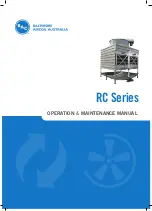
3 - HANDLING AND POSITIONING
3.1 - Handling
It is strongly recommended that a specialised lifting company is
employed to unload the machine.
Do not remove the skid or the packaging until the unit is in its
final position.
These units can be safely moved by trained personnel with a
fork lift truck with the correct capacity for the dimensions and
weight of the unit, as long as the forks are positioned in the
location and direction shown on the unit.
The units can also be lifted with slings, using only the designated
lifting points marked on the unit (labels on the chassis and label
with the unit handling instructions, attached to the unit).
Use slings with the correct capacity, and follow the lifting
instructions on the certified dimensional drawings supplied for
the unit.
Only attach slings to the clearly marked points on
the unit provided for this purpose.
It is advisable to protect coils against crushing while a unit is
being moved. Use struts or a lifting beam to spread the slings
above the unit. Do not tilt a unit more than 15°.
Safety can only be guaranteed if these instructions are carefully
followed. Otherwise there is a risk of equipment deterioration or
injury to personnel.
Keep the uprights following start-up and refit them when moving
the unit.
In some cases, uprights are added for transporting and handling
the unit. The uprights must be removed if necessary for access
or connection.
Important:
follow the disassembly procedure indicated in the disassembly
instructions.
-
Undo the bolt (3).
-
Remove the upright (2).
-
Remove the plate (1).
3.2 - Positioning
The machine must be installed in a place that is not accessible
to the public, or protected against access by non-authorised
persons.
If the unit is to be raised, ensure the machine's surroundings
permit easy access for maintenance operations.
For the centre of gravity coordinates, the position of the unit
mounting holes, and the weight distribution points, refer to the
certified dimensional drawings. Ensure the free space shown in
the dimensional drawings is respected to facilitate maintenance
and connection.
The typical applications of these units are cooling and heating,
which do not require earthquake resistance. Earthquake
resistance has not been verified.
Before positioning the unit, check that:
-
The permitted loading at the site is adequate or that
appropriate strengthening measures have been taken.
-
The unit is installed level on an even surface (maximum
tolerance is 5 mm along both axes).
-
If the support structure is sensitive to vibration and/or noise
transmission it is advisable to insert anti-vibration mounts
(elastomer mounts or metal springs) between the unit and the
structure. Selection of these devices is based on the system
characteristics and the comfort level required and should be
made by technical specialists.
-
There is adequate space above and around the unit for air to
circulate and for access to the components (see dimensional
drawings).
-
The number of support points is adequate and that they are
in the right places.
-
If the optional anti-vibration mounts are present, their number
and position must comply with the indications given on the
certified dimensional drawing.
-
The location is not subject to flooding.
-
For outdoor applications, avoid installing the unit in a location
where snow is likely to accumulate (in areas subject to long
periods of sub-zero temperatures, the unit should be raised).
-
Baffles may be necessary to deflect strong winds. They must
not restrict air flow into the unit.
Before lifting the unit, check that all casing panels
and grilles are securely fixed in place. Lift and set
down the unit with great care. Tilting and jarring
can damage the unit.
Never apply pressure or leverage to any of the unit's
panels or uprights; only the base of the unit frame
is designed to withstand such stresses. No force
or effort must be applied to pressurised parts,
especially via pipes connected to the water-cooled
heat exchanger (with or without the hydraulic
module if the unit is equipped with this).
All welding operations (connection to the hydraulic network) must
be performed by qualified welders. The Victaulic® connection or
the counter-flange must be removed before welding as a matter
of course.
AQUACIAT
POWER
ILD
EN-10











































